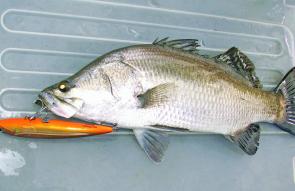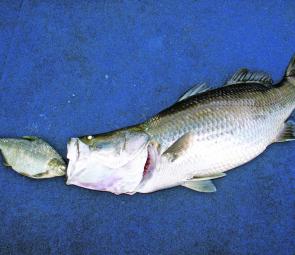The Whitsunday region should offer some prime fishing opportunities throughout August.
It’s usually a good time of year for targeting a range of fish species - from big bream in the estuaries to Spanish mackerel offshore. Any calm days with sunny skies are well worth getting out and having a fish.
The fishing for estuary species should be quite good during August with flathead, bream, golden trevally, giant trevally, queenfish, salmon, grunter and barramundi all showing up. Most of these species prefer to spend their time around similar features like areas with some type of cover or structure, lots of food, some current flow and deep water close-by.
Of course these fish will not always hang around these types of areas but this is a good idea to keep in mind when trying to locate some fish in a new area.
Mid-sized pelagics seem to prefer hunting around the mouths of estuaries, where the clear ocean water meets the coloured estuary water.
There should be some good flathead fishing casting small soft plastics around the sandy shallows this month. Flathead will move up to very skinny water, cover themselves in sand and wait for baitfish to move by. Any sandy deep drop-offs are always worth fishing over especially if there’s some current flow and baitfish present.
The Whitsunday islands should offer some exceptional fishing in certain spots during August. One good technique that can work well on medium to large queenfish, giant trevally and golden trevally is fishing the shallow island beaches on high tide. It usually works best early in the morning or late evening as predatory fish seem to feel more comfortable hunting with the slightly darker water.
Beaches that have clear water, mangroves, signs of baitfish around and a relatively even depth of 1-2m seem to always attract predatory fish at certain times. Soft plastics baitfish and crustacean imitations, surface poppers and metal chromes can work well.
The good thing about metal chrome lures is that they can be cast a long way. Combined with the fast retrieves often used with these lure types, this means that you’re covering a lot of ground when searching for pelagic fish.
Impoundment barramundi at Peter Faust Dam is another option you have in the Whitsundays. The fishing should gradually become livelier as the days progress into the warmer months. The lake is almost at full capacity so there are plenty of areas to target and fishy spots to explore.
When fishing for impoundment barramundi, match your lure size to the common size of any baitfish that you see in an area. If there are plenty of baitfish that are all the same size or type, the barramundi will sometimes seem to only feed on that particular baitfish, so ‘match the hatch’ for best results.
Big barramundi of over 1m will eat a range of different size baitfish. They will eat tiny baits that are 40mm long to very large boney bream of around 35cm!
One day we were fishing Peter Faust Dam and as we were cruising along we noticed a large barramundi floating dead on the surface. On closer inspection, we spotted that it had a large boney bream stuck in its mouth, with the tail just sticking out.
We netted the fish, which looked to be about 105cm, but the boney bream was big too, it was about the same size of the barramundi’s head. The stomach and top fins of the boney bream were firmly wedged vertically between the jaws of the fish.
It was a hard task to remove the boney bream as it was so tightly stuck. The fish must have somehow choked not being able to swallow or remove the bream. It seemed like a rare incident because if the boney came into the mouth just slightly sideways, there would have been room to fit through the jaws.
The boney was also taken head first, which is actually a common way for barramundi to eat live fish. It prevents the backwards slanting fins of baitfish from sticking and getting caught in the mouth when engulfed. The speed and accuracy required to catch a swimming boney bream in this manner is quite amazing and shows how fast these fish can actually be when they need to.
Reads: 4942
Even small barramundi will swipe at large lures like this floating Rapala X-Rap.

You can see how this barramundi has tried to eat this Rapala X-Rap head-first like they do when engulfing real fish.

Releasing a big barramundi over a metre in length is always a special experience.

This 1m+ barramundi from Peter Faust Dam was found dead on the surface with a very large boney bream stuck in its mouth.




